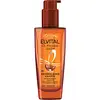What's inside
What's inside
 Key Ingredients
Key Ingredients

No key ingredients
 Benefits
Benefits

 Concerns
Concerns

 Ingredients Side-by-side
Ingredients Side-by-side

Dimethicone
EmollientIsohexadecane
EmollientC13-14 Isoparaffin
EmollientCoco-Caprylate
EmollientPhenyl Trimethicone
Skin ConditioningBis-Aminopropyl Diglycol Dimaleate
Skin ConditioningPropanediol
SolventZea Mays Oil
EmulsifyingBeta-Carotene
Skin ConditioningHelianthus Annuus Seed Oil
EmollientMoringa Oleifera Seed Oil
EmollientPunica Granatum Seed Oil
EmollientWater
Skin ConditioningMorinda Citrifolia Seed Powder
Skin ConditioningParfum
MaskingHexyl Cinnamal
PerfumingEclipta Prostrata Extract
Skin ConditioningEthylhexyl Methoxycinnamate
UV AbsorberLimonene
PerfumingTocopherol
AntioxidantCitral
PerfumingLinalool
PerfumingMelia Azadirachta Leaf Extract
Skin ConditioningCitronellol
PerfumingPseudozyma Epicola/Camellia Sinensis Seed Oil Ferment Extract Filtrate
HumectantDimethicone, Isohexadecane, C13-14 Isoparaffin, Coco-Caprylate, Phenyl Trimethicone, Bis-Aminopropyl Diglycol Dimaleate, Propanediol, Zea Mays Oil, Beta-Carotene, Helianthus Annuus Seed Oil, Moringa Oleifera Seed Oil, Punica Granatum Seed Oil, Water, Morinda Citrifolia Seed Powder, Parfum, Hexyl Cinnamal, Eclipta Prostrata Extract, Ethylhexyl Methoxycinnamate, Limonene, Tocopherol, Citral, Linalool, Melia Azadirachta Leaf Extract, Citronellol, Pseudozyma Epicola/Camellia Sinensis Seed Oil Ferment Extract Filtrate
Cyclopentasiloxane
EmollientDimethiconol
EmollientChamomilla Recutita Extract
Skin ConditioningCocos Nucifera Oil
MaskingHydroxycitronellal
PerfumingHelianthus Annuus Seed Oil
EmollientNelumbium Speciosum Flower Extract
Skin ConditioningLimonene
PerfumingBenzyl Salicylate
PerfumingBenzyl Alcohol
PerfumingLinalool
PerfumingLinum Usitatissimum Flower Extract
Skin ConditioningIsoeugenol
PerfumingCaprylic/Capric Triglyceride
MaskingGeraniol
PerfumingGardenia Taitensis Flower Extract
Skin ConditioningRosa Canina Flower Extract
AstringentBisabolol
MaskingHexyl Cinnamal
PerfumingGlycine Soja Oil
EmollientParfum
MaskingCyclopentasiloxane, Dimethiconol, Chamomilla Recutita Extract, Cocos Nucifera Oil, Hydroxycitronellal, Helianthus Annuus Seed Oil, Nelumbium Speciosum Flower Extract, Limonene, Benzyl Salicylate, Benzyl Alcohol, Linalool, Linum Usitatissimum Flower Extract, Isoeugenol, Caprylic/Capric Triglyceride, Geraniol, Gardenia Taitensis Flower Extract, Rosa Canina Flower Extract, Bisabolol, Hexyl Cinnamal, Glycine Soja Oil, Parfum
 Reviews
Reviews

Ingredients Explained
These ingredients are found in both products.
Ingredients higher up in an ingredient list are typically present in a larger amount.
Helianthus Annuus Seed Oil is the oil derived from the seeds of a Sunflower. Sunflower seed oil is non-fragrant. It is an emollient, meaning it helps to soften the skin.
Sunflower seed oil contains many fatty acids. The fatty acids found in sunflower seeds include (from highest amount to least): linoleic acid, myristic acid, palmitic acid, stearic acid, arachidic acid, oleic acid, and linolenic acid.
These fatty acids help the skin create ceramides. Ceramides play a role in repairing the skin barrier.
Helianthus Annuus Seed Oil helps moisturize the skin. This in turn helps the skin look more rejuvenated and smoother.
Sunflowers are rich in vitamin E.
Historians believe Indigenous cultures of North America domesticated sunflowers before corn. Thus they relied on sunflower oil for a variety of uses. One such use is moisturizing skin and hair.
Sunflower seed oil may not be fungal acne safe. We recommend speaking with a professional if you have any concerns.
Learn more about Helianthus Annuus Seed OilHexyl Cinnamal is a fragrance ingredient with a similar scent to jasmine. It can be naturally found in chamomile essential oil.
This ingredient is a known EU allergen and may sensitize the skin. The EU requires this ingredient to be listed separately on an ingredients list.
Hexyl Cinnamal is not water soluble but is soluble in oils.
Learn more about Hexyl CinnamalLimonene is a fragrance that adds scent and taste to a formulation.
It's found in the peel oil of citrus fruits and other plants such as lavender and eucalyptus. The scent of limonene is generally described as "sweet citrus".
Limonene acts as an antioxidant, meaning it helps neutralize free radicals.
When exposed to air, oxidized limonene may sensitize the skin. Because of this, limonene is often avoided by people with sensitive skin.
The term 'fragrance' is not regulated in many countries. In many cases, it is up to the brand to define this term. For instance, many brands choose to label themselves as "fragrance-free" because they are not using synthetic fragrances. However, their products may still contain ingredients such as essential oils that are considered a fragrance.
Learn more about LimoneneLinalool is a fragrance and helps add scent to products. It's derived from common plants such as cinnamon, mint, citrus, and lavender.
Like Limonene, this ingredient oxidizes when exposed to air. Oxidized linalool can cause allergies and skin sensitivity.
This ingredient has a scent that is floral, spicy tropical, and citrus-like.
Learn more about LinaloolParfum is a catch-all term for an ingredient or more that is used to give a scent to products.
Also called "fragrance", this ingredient can be a blend of hundreds of chemicals or plant oils. This means every product with "fragrance" or "parfum" in the ingredients list is a different mixture.
For instance, Habanolide is a proprietary trade name for a specific aroma chemical. When used as a fragrance ingredient in cosmetics, most aroma chemicals fall under the broad labeling category of “FRAGRANCE” or “PARFUM” according to EU and US regulations.
The term 'parfum' or 'fragrance' is not regulated in many countries. In many cases, it is up to the brand to define this term.
For instance, many brands choose to label themselves as "fragrance-free" because they are not using synthetic fragrances. However, their products may still contain ingredients such as essential oils that are considered a fragrance by INCI standards.
One example is Calendula flower extract. Calendula is an essential oil that still imparts a scent or 'fragrance'.
Depending on the blend, the ingredients in the mixture can cause allergies and sensitivities on the skin. Some ingredients that are known EU allergens include linalool and citronellol.
Parfum can also be used to mask or cover an unpleasant scent.
The bottom line is: not all fragrances/parfum/ingredients are created equally. If you are worried about fragrances, we recommend taking a closer look at an ingredient. And of course, we always recommend speaking with a professional.
Learn more about Parfum